|
|
 |
|
Gardening Blog
|
 |
|
|
Friday, January 22, 2010
More on Freeze Damage
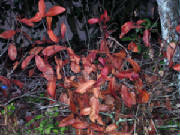 I am continuing to get questions about the freeze damage to landscape plants. All hope is not lost.
Most of t I am continuing to get questions about the freeze damage to landscape plants. All hope is not lost.
Most of t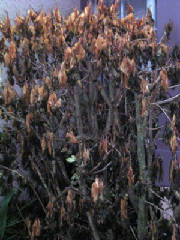 he plants, especially the woody shrubs will recover, but it may take a while for them to return to their former size.
I cannot stress enough how important it is to be patient. Even I am so tempted to prune the sad
looking plants in my landscape. he plants, especially the woody shrubs will recover, but it may take a while for them to return to their former size.
I cannot stress enough how important it is to be patient. Even I am so tempted to prune the sad
looking plants in my landscape.
It is possible that we can still have another frost or freeze event before spring comes. The
brown leaves on plants such as plumbago, croton, hibiscus, gold mound Duranta, Ixora, and firebush will help protect the plant
in another cold snap. If some sprouts appear during warmer weather, the dead leaves can offer some protection.
Almost all of these plants will sprout new growth in the spring. Even if a plant is dead to the
ground, it might sprout from the roots. We did not have weather cold enough to freeze the ground in most
of Florida.
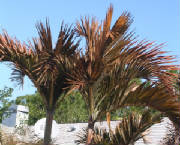 If you have palms that look like some of these pictures, it is very If you have palms that look like some of these pictures, it is very 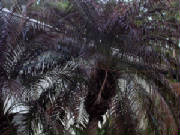 important that you spray the bud with Copper fungicide. This will kill any fungus that starts to grow on
dying tissue. This fungus might kill the bud. Palms only have one growing point, or bud, and when it is
dead, the palm is dead. Please reference the UF/IFAS Extension publication Treating Cold Damaged Palms at: http://edis.ifas.ufl.edu/MG318 for complete directions. important that you spray the bud with Copper fungicide. This will kill any fungus that starts to grow on
dying tissue. This fungus might kill the bud. Palms only have one growing point, or bud, and when it is
dead, the palm is dead. Please reference the UF/IFAS Extension publication Treating Cold Damaged Palms at: http://edis.ifas.ufl.edu/MG318 for complete directions.
I have added some pictures of plants in my immediate area. There is a lot of damage even
down into Largo and St. Petersburg.
Thursday, January 21, 2010
Pruning freeze damaged bananas
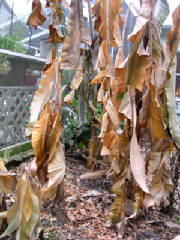 I received a question from a subscriber who asks: How do I tell if I have pruned my banana plants correctly?
I indicated in my previous post that banana plants were one of the plants that can be pruned back immediately
after freeze damage occurs. They are herbaceous (do not have real bark) and will sprout directly from the middle of
the stalk, if it is still living. Many times you will see this sprouting in a day or two after pruning. 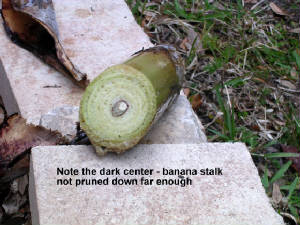 Use a pruning saw to cut the stalk about 1/3 of the way down from the top - this will usually remove all of the dead
leaves. If you see a dark area in the center of the stalk, you have not removed all of the area effected by the freeze
and you will need to remove more of the stalk. Move down about 10 - 12 inches and cut the stalk again. 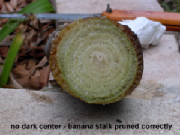 If you still see the dark center, you will need to continue taking off a bit at a time until you see a light cream to green
center. Once you get to this point on the stalk you have reached the area where new leaves are still living. In
a few days you should see a new leaf emerging from the center of the pruned stalk that will continue to grow and unfurl. If
you find that you must cut your bananas all the way back to the soil line, they will most likely sprout new plants from the
existing roots. Hopefully we will not experience more freezing weather this winter, but there are no guarantees. Pam
2:13 pm est
Thursday, January 14, 2010
After the Freeze - what to do now
The Arctic blast that
brought record breaking freezing or near freezing temperatures to our area for a number of nights in a row is finally behind
us. Many of the plants that we have in our landscapes here in north Pinellas County were vulnerable to these temperatures.
Once the temperature fell below 30 degrees for several hours, even covering plants did not completely protect them.
Plants that have been damaged
by the cold will look wilted, the leaves might turn brown and die, and some plants can look melted. Resist
the temptation to start pruning these plants back. The damaged leaves help to insulate damaged plants from
frost and further injury.
Wait to prune cold-damaged oleanders and other tropical shrubs such
as hibiscus and crotons until after they begin to sprout new growth with the onset of warm weather, maybe by late February.
Once plants begin to sprout, be sure to prune below the new sprouts so that you cut into green healthy wood.
Fertilize only after you see healthy new growth on these plants. It is often difficult to
determine how far freeze damage extends. If you are worried that the plant is dead, gently scrape the bark near the base of
a stem, if the cambium layer just under the bark is still green then the plant is alive.
Some herbaceous plants, such as bananas, coleus,
impatiens, gingers and begonias, have collapsed and need to just be cut down and removed. This will reduce fungal or bacterial
problems as these dead plants decay. Banana plants will usually send up new pups from the root system in the spring.
Large banana stalks can be cut about midway down to the roots. If you see healthy light green tissue
in the middle of the stem, it might sprout from this point. If the interior of the stalk is brown, cut
back further down the stalk until you find healthy tissue.
I have also seen many cold sensitive palms planted in our area that
have been damaged by freezing temperatures. You can possibly save them by treating the growing bud with Copper fungicide.
The UF/IFAS Extension publication Treating Cold Damaged Palms is available at: http://edis.ifas.ufl.edu/MG318
You may also
find that your lawn has been damaged by freezing temperatures especially in open or exposed areas. Our most common lawn grass,
Floratam St. Augustine, is the most sensitive to cold temperatures. Zoysia, Bermuda and Bahia grass are more cold tolerant.
Grass blades turn brown or burnt looking following a hard freeze or the blades can look wilted, then turn whitish and then
black. All might not be lost – but you will have to wait until spring to really know for sure. Cold damage initially
looks like drought stress, but adding too much water while the grass is nearly dormant is not necessary and will waste water
resources. Let the brown leaf blades remain and skip mowing until the grass is actually growing. The dead blades can provide
insulation from future cold for healthy rhizomes growing close to the ground. Postpone spring fertilization until you see
some re-growth of the turf indicating that the grass can utilize the fertilizer. More information can be
found in the University of Florida (UF)/IFAS Extension publication Low Temperature Damage to Turf at: http://edis.ifas.ufl.edu/LH067
I know that it is hard to wait when there is unsightly damage in the landscape, but winter may not be finished
with us yet. The end of February is when we should see some significant recovery – Be patient
4:54 pm est
Wednesday, January 6, 2010
Cold Protection for Landscape Plants
We are experiencing a string of cold nights that may turn out to be quite damaging for our landscapes. We have had some
frost and below freezing temperatures in our immediate area of north Pinellas County. We will get a bit
of a reprieve Thursday and Thursday night. Friday night brings in more lower temperatures - 32 degrees, then Saturday
and Sunday nights predicted to be around 29 degrees. There is a 30% chance of rain on Friday, so any covers you have
on your plants should be removed so they don't become soaked. It is best to also turn off your automatic irrigation
system when plants are covered or freezing temperatures are expected. Cold sensitive plants in pots
should be moved into a protected garage or inside. Orchids and other tropical plants fall into this category.
Those that cannot be moved should be covered with old blankets, sheets or frost cloth. The covering must come all the
way to the ground - the objective is to capture any heat in the soil before it radiates back to the sky at night. Water potted plants well before covering them (moist soil retains more heat and well hydrated plants can suffer
less damage). This also applies to sensitive plants that are in the ground. Water them well and then cover them
before dark. If temperatures fall below freezing for 3 hours or more, covering may not help. Many of our woody
plants might loose all of their leaves from freeing temperatures, but they should leaf out in the spring with some die back.
The following plants are just a short list of those that should be covered: Hibiscus, Crotons, Ti
plant, Ixora, Allamanda, Duranta (Gold Mound), Plumbago, Impatiens (to protect from frost - freezing will kill them), geraniums,
begonias, bromeliads, gingers, heliconia, and Crown of thorns. Bananas are very cold sensitive and may freeze back to
the ground, but the roots should send up new sprouts in the spring Common palms that can be damaged by freezing
temperatures include: Pygmy date, Bismark, Adonidia, Royal, Foxtail, Areca and Coconut among others. It usually takes temperatures
in the mid 20s to completely kill these palms, but the fronds may turn brown and die. If this happens, research at the
Univ. of Fl. has shown that treating the growing area (bud at the top) with a copper fungicide can help palms recover.
For more information, you can access their publication "Treating Cold Damaged Palms" on the Internet at: http://edis.ifas.ufl.edu/pdffiles/MG/MG31800.pdf It is important to know the hardiness zone of your palms and other landscape plants. Here in
north Pinellas County, we are in zone 9b. If you are lucky to live near the Gulf, Tampa Bay, or one of our many lakes
and ponds, your temperatures will be moderated by this water. This can help to reduce cold damage to landscape plants.
If your plants do loose all of their leaves, resist the urge to prune them now. Wait until at least the
middle of February. Plants should start to put our new leaves then and you can tell how much you will need to prune back. I have already seen some frost damage on plants that I did not get covered last night. I just can't cover them
all. Stay warm, Pam
|
|
To subscribe to this blog - click on XML icon.
|
 |
|
|
|
 |
|
|
Pampered Gardeners LLC * Oldsmar, FL * USA * Phone: 727 483-3783 * pam@pamperedgardeners.com
|
|
|
 |

